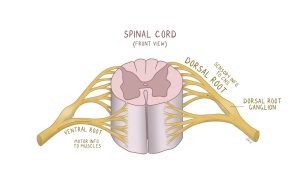40
What is the spinal cord?
The spinal cord is like a twisted rope-like structure extending down from the brainstem through the vertebral column and branches off at the bottom, as if the rope is frayed. Projections of the spinal cord branch off through the intervertebral foramen, innervating and receiving signals from nearby muscles and organs. With the spinal cord branching off at each vertebra, the spinal cord gradually tapers until it ends near L1 or L2, and transitions into several bundles of nerves which resemble a horse’s tail, giving them the name cauda equina.
Branching immediately from these spinal cords are the dorsal and ventral roots. The dorsal root as the name suggests, originates from the dorsal or back side of the spinal cord and relays sensory info. Just distal to the dorsal root is the dorsal root ganglion which houses sensory neuron bodies. On the ventral or front side of the spinal cord is the ventral root which relays motor info.

Figure 94 Cross section of the spinal cord
Within the spinal cord several kinds of sensory information are relayed from the body’s various sensors that lead all the way to the brain. These senses are touch, pressure, temperature, pain (also called nociception) and proprioception (awareness of your body in space). Starting with touch and pressure, these senses detected by various corpuscles and cells on the skin send signals which travel up through white matter tracts of the spinal cord to reach the brain. Pain and temperature which are detected through free nerve endings on the skin travel up similar tracts. Finally, proprioception, which is detected through spindle fibres throughout the body, is also sent up the spinal cord.

